- Anatomical terminology
- Skeletal system
- Joints
- Muscles
- Heart
- Blood vessels
- Lymphatic system
- Nervous system
- Respiratory system
- Digestive system
- Urinary system
- Female reproductive system
- Male reproductive system
- Endocrine glands
- Eye
- Ear
Dental notation systems
Dental practitioners worldwide use various systems to make descriptions and write down information about the teeth of their patients. These teeth numbering systems are known as dental notation systems, and they are standardized ways of identifying a location of a specific tooth in the oral cavity. These systems accurately describe a particular tooth to ensure consistent and effective communication between dental professionals.
Several dental notation systems are used all over the world. However, the FDI system, also known as the ISO-3950 system, is the most commonly used dental notation system. Besides the FDI system, two more systems are well-known and widely used, and they include the Universal Tooth Numbering System and Palmer notation system. The Universal Tooth Numbering System is primarily used in the USA, while dentists in the UK prefer to use the Palmer notation system.
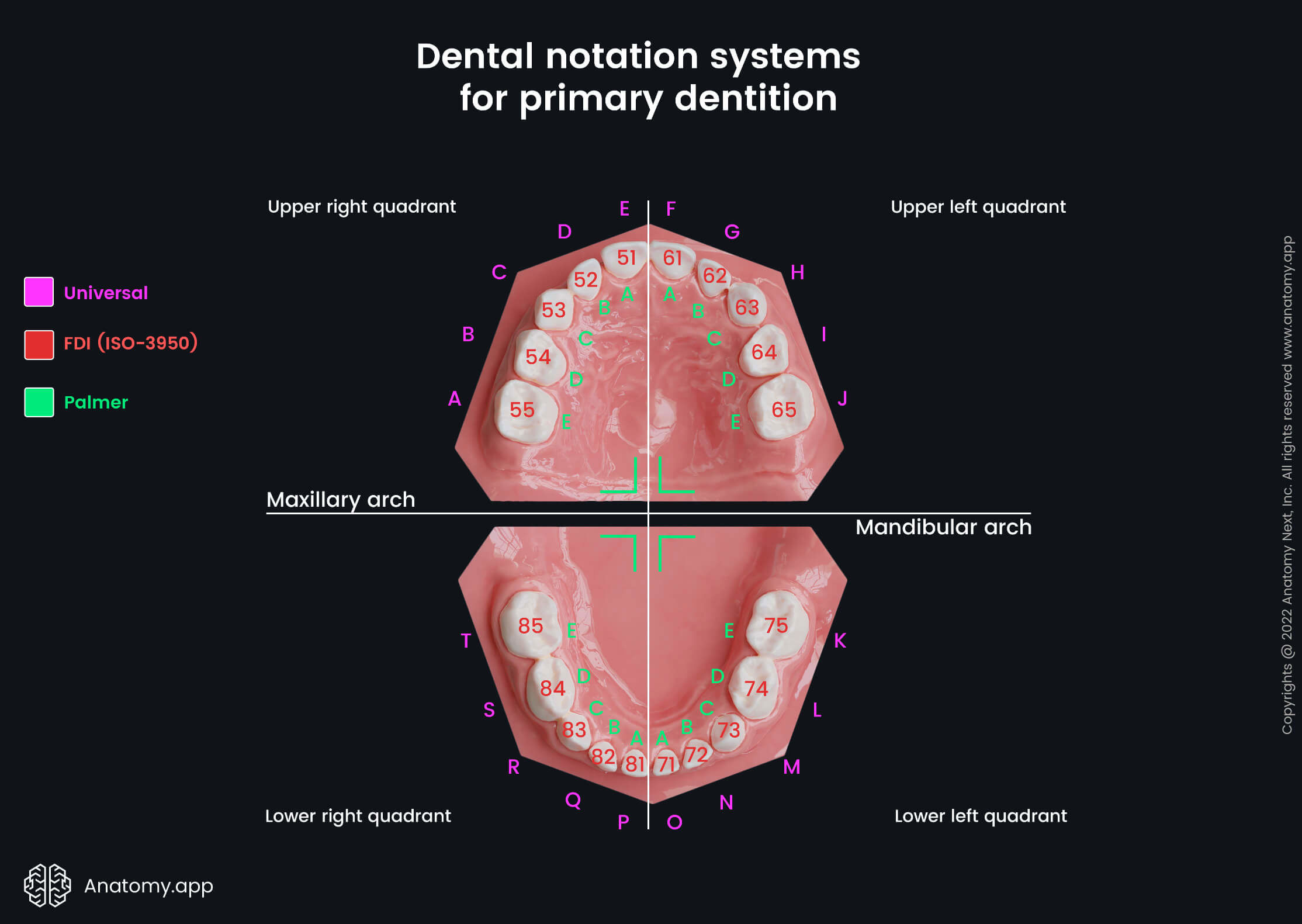

Regardless of which system mentioned above is used, each assigns a unique number, letter or symbol to each tooth, allowing dentists to precisely identify teeth and plan treatments in a consistent and efficient manner. Moreover, each system has different numbers, letters or symbols for each dentition. To sum up, the use of dental notation systems helps to avoid confusion and improve the accuracy of dental records, ultimately leading to better patient care.
Note: Each quadrant in the second illustration lacks third molars.
FDI (ISO-3950) dental notation system
The FDI dental notation system, also known as the ISO-3950 system, is an international standardized dental notation system developed by the World Dental Federation (FDI; Federation Dentaire Internationale). It is an international organization representing over 200 national dental associations.
This system is called either the FDI dental notation system or the ISO-3950 system, as later it was adopted by the World Health Organization (WHO) and International Standard Organization (ISO).
The FDI notation system assigns a two-digit number to each tooth. Therefore, each tooth is described using two numbers:
- The first number represents the quadrant (upper right, upper left, lower left, or lower right) where the tooth is located. The counting starts from the upper right quadrant and goes opposite the clockwise direction.
- The second number is the sequence number of a particular tooth within the quadrant. The counting starts from the medial (central) incisor and continues to the last molar tooth.
The FDI dental notation system is widely used in many countries and is considered to be a more universally accepted system compared to other dental notation systems.
FDI (ISO-3950) system for primary dentition
As mentioned above, the FDI system is a two-digit numbering system. The first digit describes the quadrant in which the particular tooth is located:
- Upper right quadrant (maxillary) - 5;
- Upper left quadrant (maxillary) - 6;
- Lower left quadrant (mandibular) - 7;
- Lower right quadrant (mandibular) - 8.
The second digit corresponds to the sequence number of a specific tooth in the quadrant:
- Medial (central) incisors - 1;
- Lateral incisors - 2;
- Canines - 3;
- First molars - 4;
- Second molars - 5.
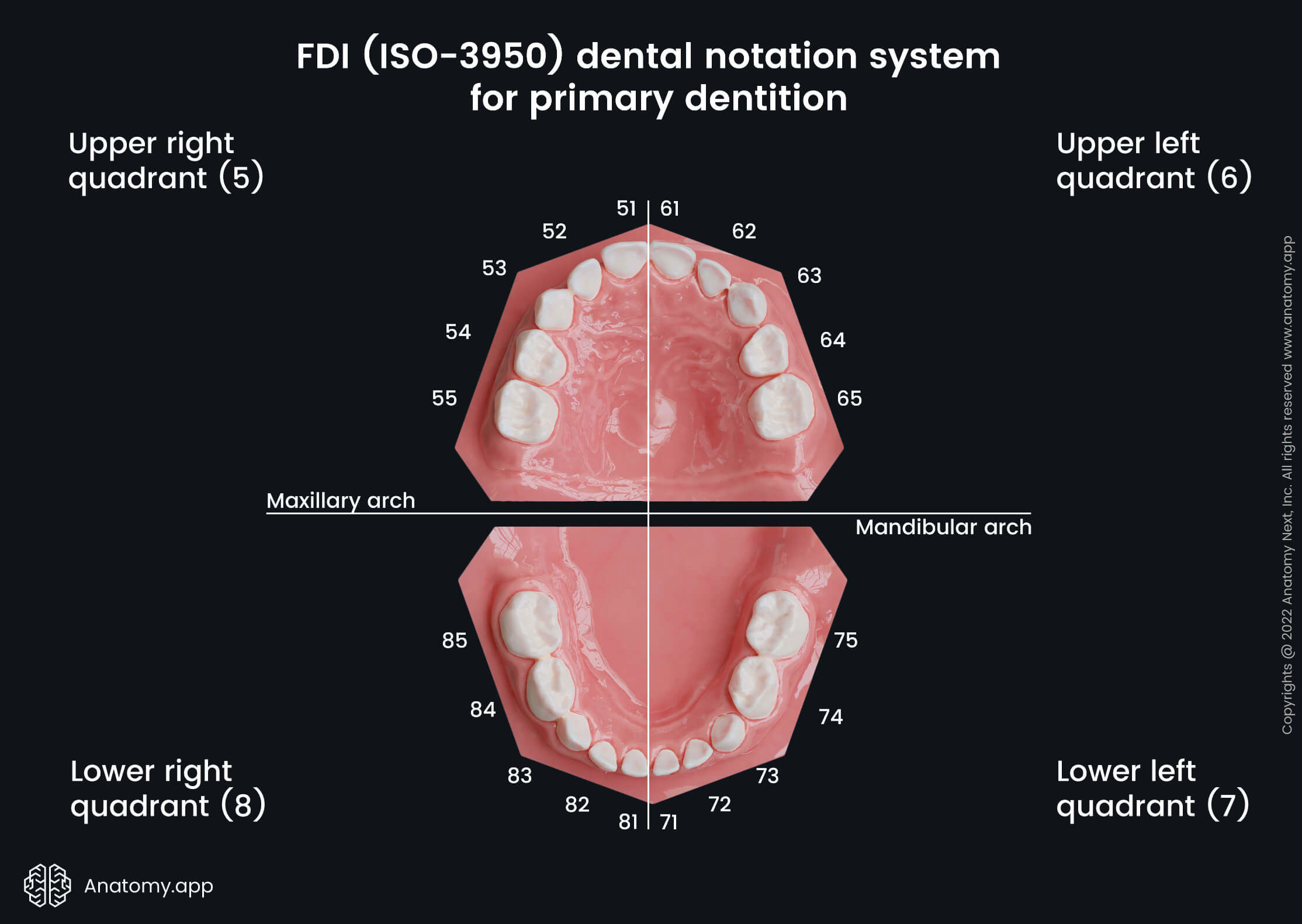
For example, the canine tooth in the upper left quadrant has a numbering of 63:
- 6 - refers to the upper left quadrant;
- 3 - used to describe the canine, as it is the third tooth from the midline of the upper jaw.
FDI (ISO-3950) system for permanent dentition
The quadrants for the permanent dentition are numbered as follows:
- Upper right quadrant (maxillary) -1;
- Upper left quadrant (maxillary) - 2;
- Lower left quadrant (mandibular) - 3;
- Lower right quadrant (mandibular) - 4.
The sequence number of each permanent tooth within the quadrant is as follows:
- Medial (central) incisors - 1;
- Lateral incisors - 2;
- Canines - 3;
- First premolars - 4;
- Second premolars - 5;
- First molars - 6;
- Second molars - 7;
- Third molars (wisdom teeth) - 8.
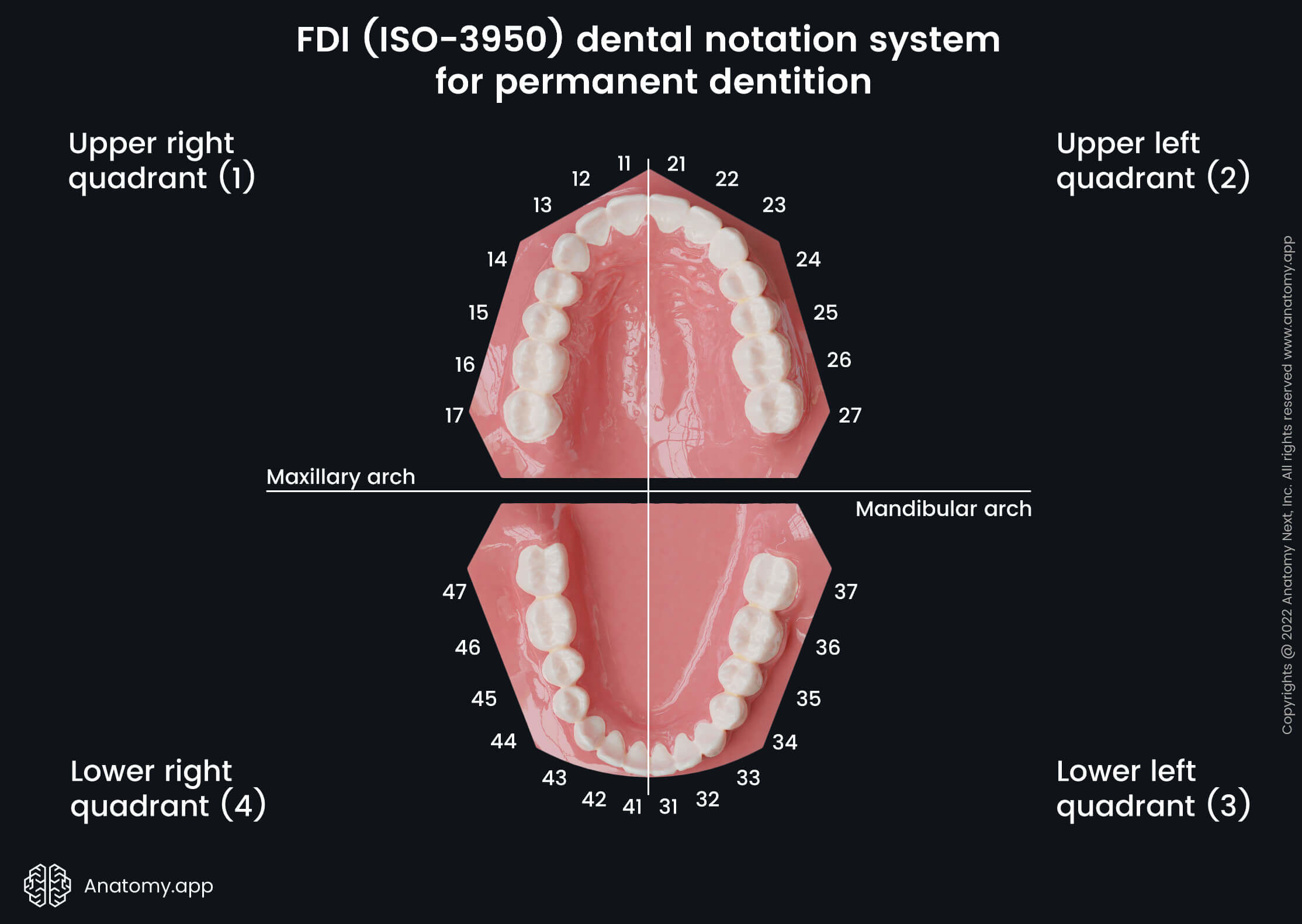
For example, the canine tooth in the upper left quadrant has a numbering of 23:
- 2 - used to describe the left upper quadrant;
- 3 - refers to the canine, as it is the third tooth from the midline of the upper jaw.
Note: Each quadrant in the illustration lacks third molars.
Palmer notation system
The Palmer notation system was invented by Dr.Palmer in the late 19th century. It remains in use today, particularly in the United Kingdom. It is also known as the Zsigmondy or Palmer-Zsigmondy system.
In this system, each quadrant is identified by a special symbol ( ⏌,⎿ , ⏋,⎾ ) instead of a number or letter. In contrast, the teeth are marked using letters or numbers, depending on the dentition:
- The primary teeth are identified with uppercase letters.
- The permanent teeth are described with numbers.
The Palmer system has the advantage of being a simple and easy-to-learn system. However, it is not widely used or recognized as the two previously mentioned systems.
Palmer system for primary dentition
According to the Palmer system, each quadrant is marked with a specific symbol or a letter combination in the electronic recording:
- Upper right quadrant (maxillary) - ⏌ or UR in electronic recording;
- Upper left quadrant (maxillary) - ⎿ or UL in electronic recording;
- Lower left quadrant (mandibular) - ⎾ or LL in electronic recording;
- Lower right quadrant (mandibular) - ⏋or LR in electronic recording.
Each primary tooth is indicated by a letter from A to E:
- Medial (central) incisors - A;
- Lateral incisors - B;
- Canines - C;
- First molars - D;
- Second molars - E.
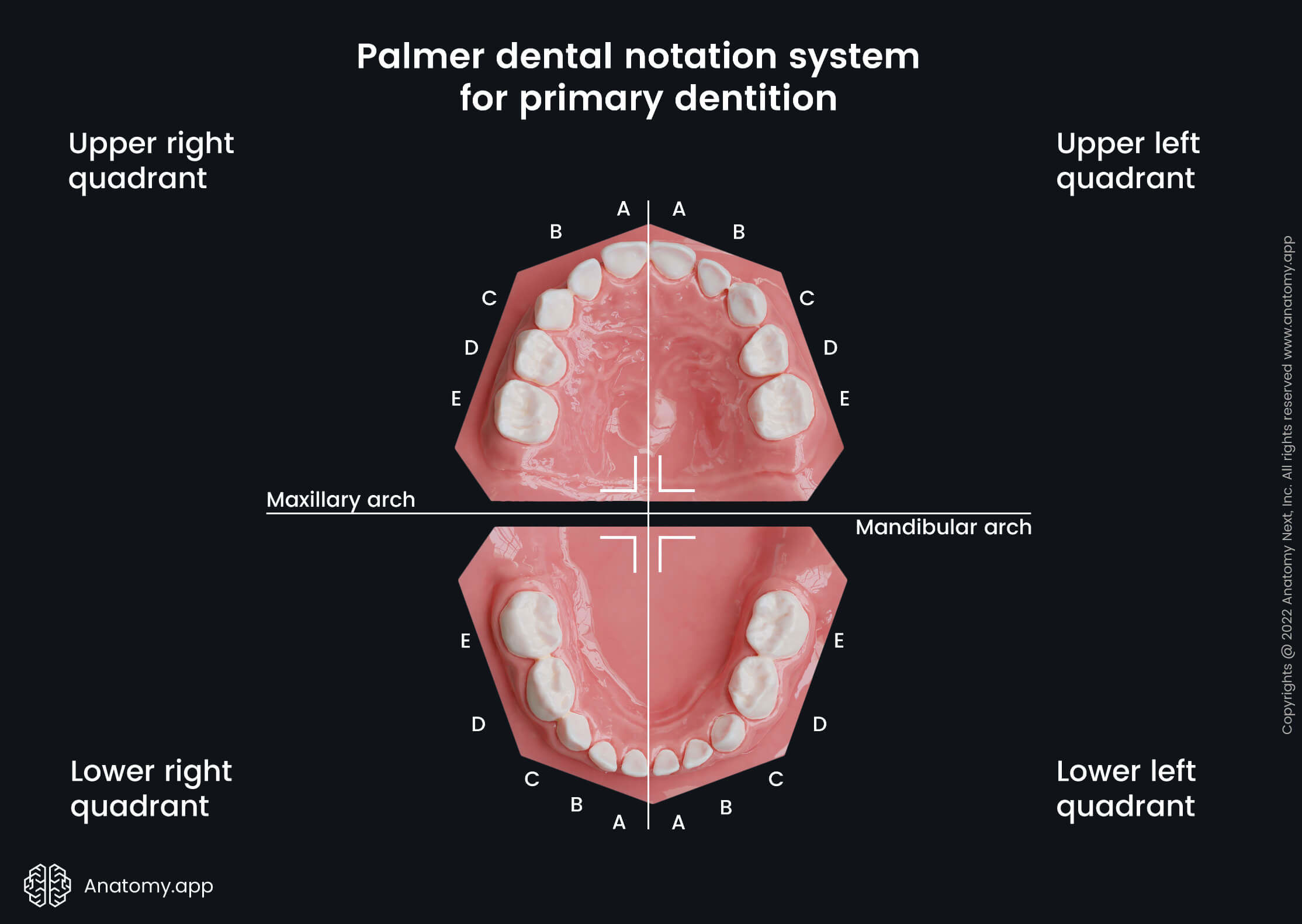
Therefore, the first molar in the upper left quadrant of the primary dentition is described with⎿D:
- The symbol "⎿ " is used to recognize the upper left quadrant;
- D refers to the first molar tooth.
Palmer system for permanent dentition
The symbols or letter combinations (in electronic recordings) describing quadrants for the permanent dentition remain the same as for the primary teeth:
- Upper right quadrant (maxillary) - ⏌ or UR in electronic recording;
- Upper left quadrant (maxillary) - ⎿ or UL in electronic recording;
- Lower left quadrant (mandibular) - ⎾ or LL in electronic recording;
- Lower right quadrant (mandibular) - ⏋or LR in electronic recording.
In contrast, the permanent teeth are each given a number from 1 to 8:
- Medial (central) incisors - 1;
- Lateral incisors - 2;
- Canines - 3;
- First premolars - 4;
- Second premolars - 5;
- First molars - 6;
- Second molars - 7;
- Third molars (wisdom teeth) - 8.
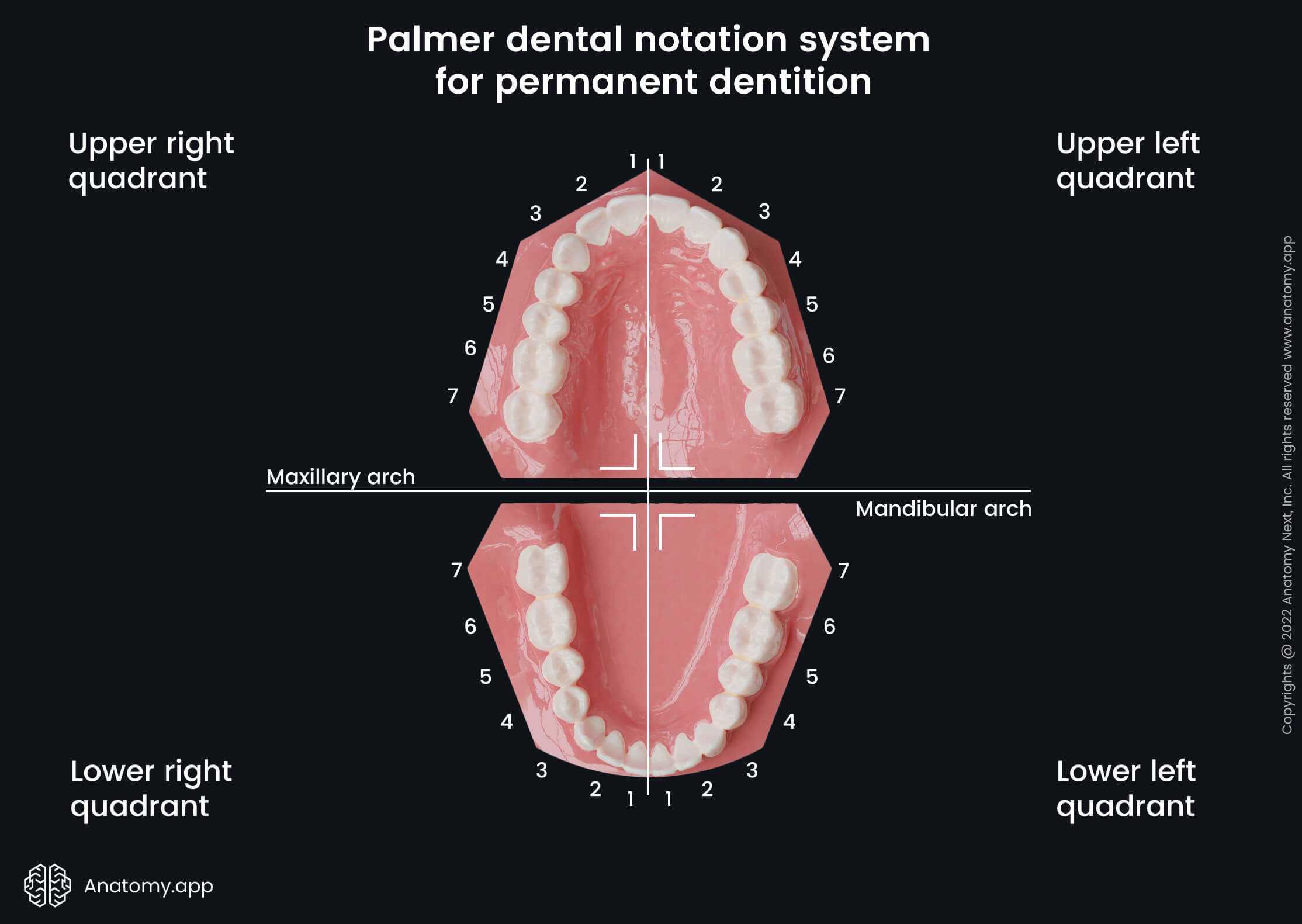
For example, the lateral incisor in the upper left quadrant of the secondary dentition is described as⎿2:
- The symbol "⎿ " is used to recognize the upper left quadrant;
- 2 refers to the lateral incisor.
Note: Each quadrant in the illustration lacks third molars.
Universal Tooth Numbering System
The Universal Tooth Numbering System is another standardized dental notation system. It is also known as the American or National Numbering System, as it is mainly used in the United States of America.
This system uses only one uppercase letter to describe the teeth of the primary dentition and one or two numbers to identify the teeth of the secondary dentition. According to this numbering system, the counting of the teeth starts from the upper right quadrant and goes opposite the clockwise direction. From the upper right quadrant, it continues to the left side, then goes down and ends in the lower right quadrant.
- In the Universal Tooth Numbering System, each tooth of primary dentition is assigned a unique letter from A to T, with the upper right second molar being A and the lower right second molar being T.
- In contrast, each tooth of permanent dentition is identified by a number from 1 to 32, with the upper right third molar being 1 and the lower right third molar being 32.
Universal Tooth Numbering System for primary dentition
The numbering of each primary tooth in each quadrant according to the Universal Tooth Numbering System is summarized in the table below.
Upper right quadrant | Upper left quadrant | ||||||||
A | B | C | D | E | F | G | H | I | J |
Lower right quadrant | Lower left quadrant | ||||||||
T | S | R | Q | P | O | N | M | L | K |
Incisors
Canines
Molars
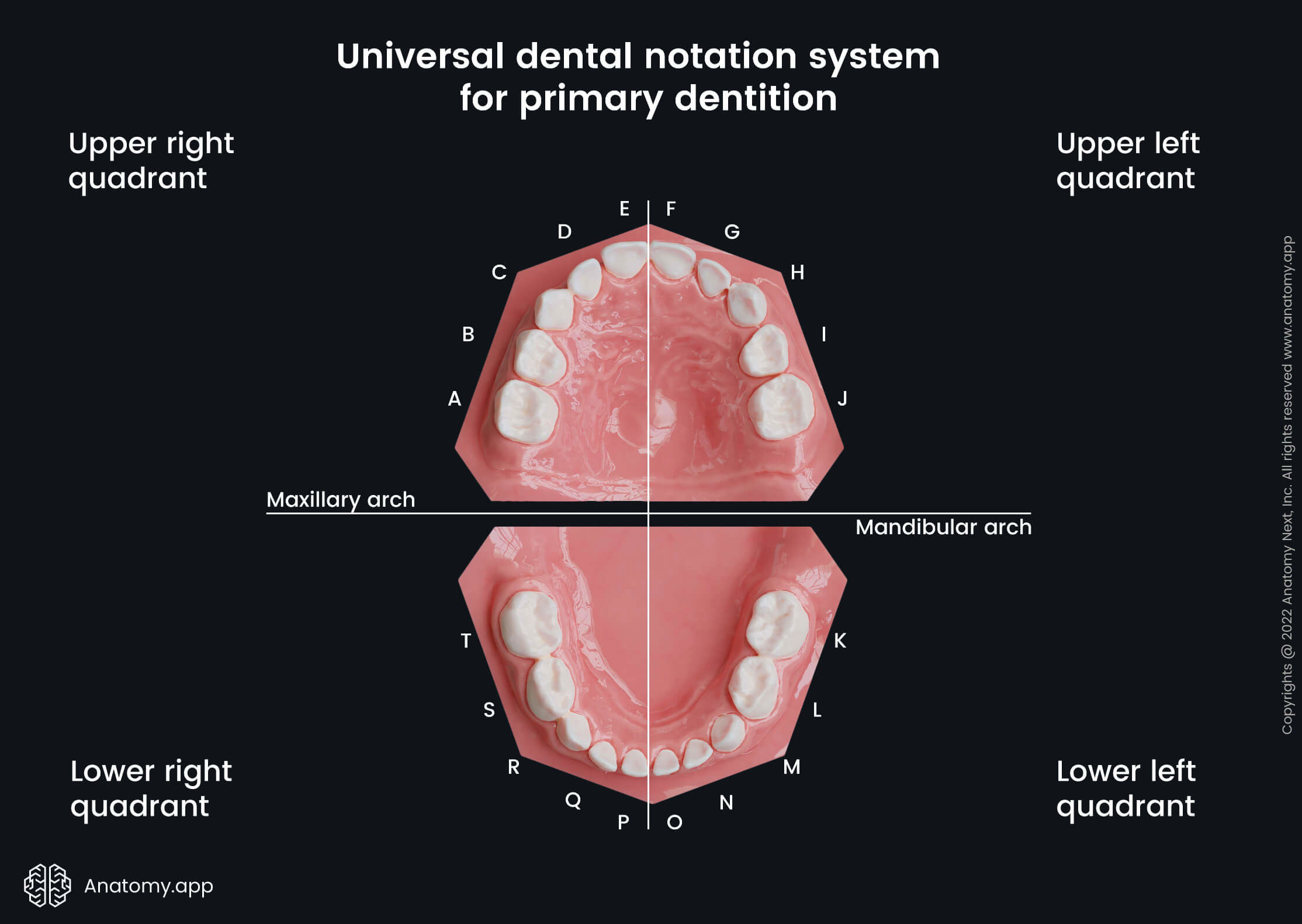
Universal Tooth Numbering System for permanent dentition
The numbering of each permanent tooth in each quadrant is summarized in the table below.
Upper right quadrant | Upper left quadrant | ||||||||||||||
1 | 2 | 3 | 4 | 5 | 6 | 7 | 8 | 9 | 10 | 11 | 12 | 13 | 14 | 15 | 16 |
Lower right quadrant | Lower left quadrant | ||||||||||||||
32 | 31 | 30 | 29 | 28 | 27 | 26 | 25 | 24 | 23 | 22 | 21 | 20 | 19 | 18 | 17 |
Incisors
Canines
Premolars
Molars

Note: Each quadrant in the illustration lacks third molars.